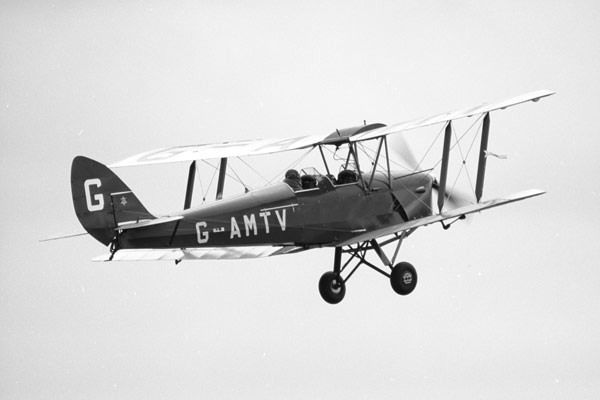
DeHavilland Tiger Moth DH82a G-AMTV. Built at Hatfield in 1938, she served with EFTS 22 and 21 at RAF Cambridge and Booker before being stored then sold into civilianship at the end of the war. From there she was sold as an instrument flying trainer to Belgium before eventually being retired in 1969. She was bought in 1989, shipped back to the UK and then rebuilt by Aero Antiques to concourse, zero-time condition. The full canopy she had been fitted with came off, as did the steerable tailwheel and brakes - but they left the electric start on, as it's kind of useful.
The aircraft was then sold to a ten-strong consortium in 1993, which I joined in 1997. Owning a share in an aircraft is a double-edged sword. The upside is that you get to fly a slice of vintage aviation history for a lower-than-usual figure, but the downside is that you have to share your aircraft with other people, and since I am firmly of the conviction that one out of every five pilots is a clot, Tango Victor's group would have a minimum of two twits in the group - as it turned out.
I did about a hundred hours in her during the six years before she ended up a wreck upside down in a wheat field, and Mari and I did quite a few rallies with the Tiger Moth Club, which is a Very Special Organisation indeed, run by the tireless McKay family, and populated by such a collection of English eccentrics and adventurers that it quite makes ones head spin. We took her to Woburn twice, where the Duke (and Latterly Duchess) allowed the club to mark out a runway on their front lawn, and one would then approach over the elephants, line up with the runway and then sideslip steeply to lose hight as the approach (and climb-out) are hemmed in by tall trees. The lakes and shrubs, like on a golf course, are natural hazards that are to played around.
It will be hard for me to admit that this was the aircraft that was most practical to fly as it was neither particularly warm, economic, fast, long-legged, or was even that manoeuvrable - and it certainly wasn't fond of crosswinds and leaked - chucked out - about a pint of oil an hour. But it was the most enjoyable aircraft to be in - in much the same way as a Bentley 4.5 Litre is not really practical, but hugely enjoyable to be around. From the bark of the engine note to the hum of the flying wires to the peculiarly satisfying feeling of a well-executed roll, she was just glorious. She even smelled good - a heady mixture of avgas, dope, leather and oil-soaked wood.
But was the DH82a a good design? Not really. It was the cobbling together of the earlier DH60M Moth to conform to RAF trainer requirements that saw deHavillands arrange the wings thus, to allow easy exit for the student up front, but maintain the CofG. Add a healthier engine and bing - Tiger. To be fair, she was designed for an era in which you always landed into wind, and to have a proper trainer up and running in such short time would have been impossible with the storm clouds gathering. She filled a niche, and still does. My father learned to fly in one, as did most pilots of the last war. History, but in the air - and alive. Not sad and dead and empty in a museum.
I took her all over the place and after basing her at Old Sarum we moved to Oaksey Park, ostensibly to find more people willing to buy a share, as many pilots like the idea of flying a Tiger, but less actually enjoy it once in the driver's seat. We always had at least two shares for sale, and we lowered entry requirements to join, which was the first in a series of mistakes. The excellent leader of the group left for NZ which was a blow, and after a series of mishaps - one of them mine when I nosed her over in a squall at Old warden, she 'failed to gain flying speed' and tumbled end over end into said wheat field. I wasn't there, but saw the pictures and the aftermath, which was a huge shame - all four wings broken, cabane struts bent, and fin and rudder broken, engine shock loaded. No damage to occupants, as the energy is absorbed by all those breakable bits. We all gave up then, and split the insurance money ten ways, and moved on.
I tried to buy the wreck but was bid out at £8000. She is flying again now, as Tigers rarely die. She was offered to me for sale, and I was sorely tempted. But the idea of paying all the maintenance bills all on my own was a responsibility I'm not sure I wanted. Maybe another time.
|